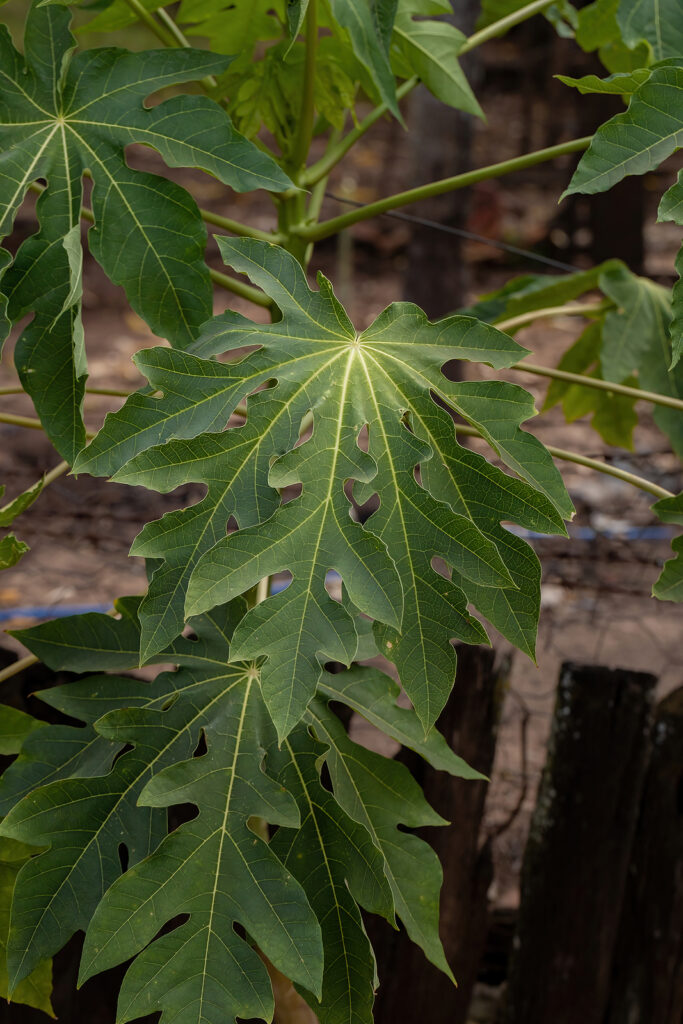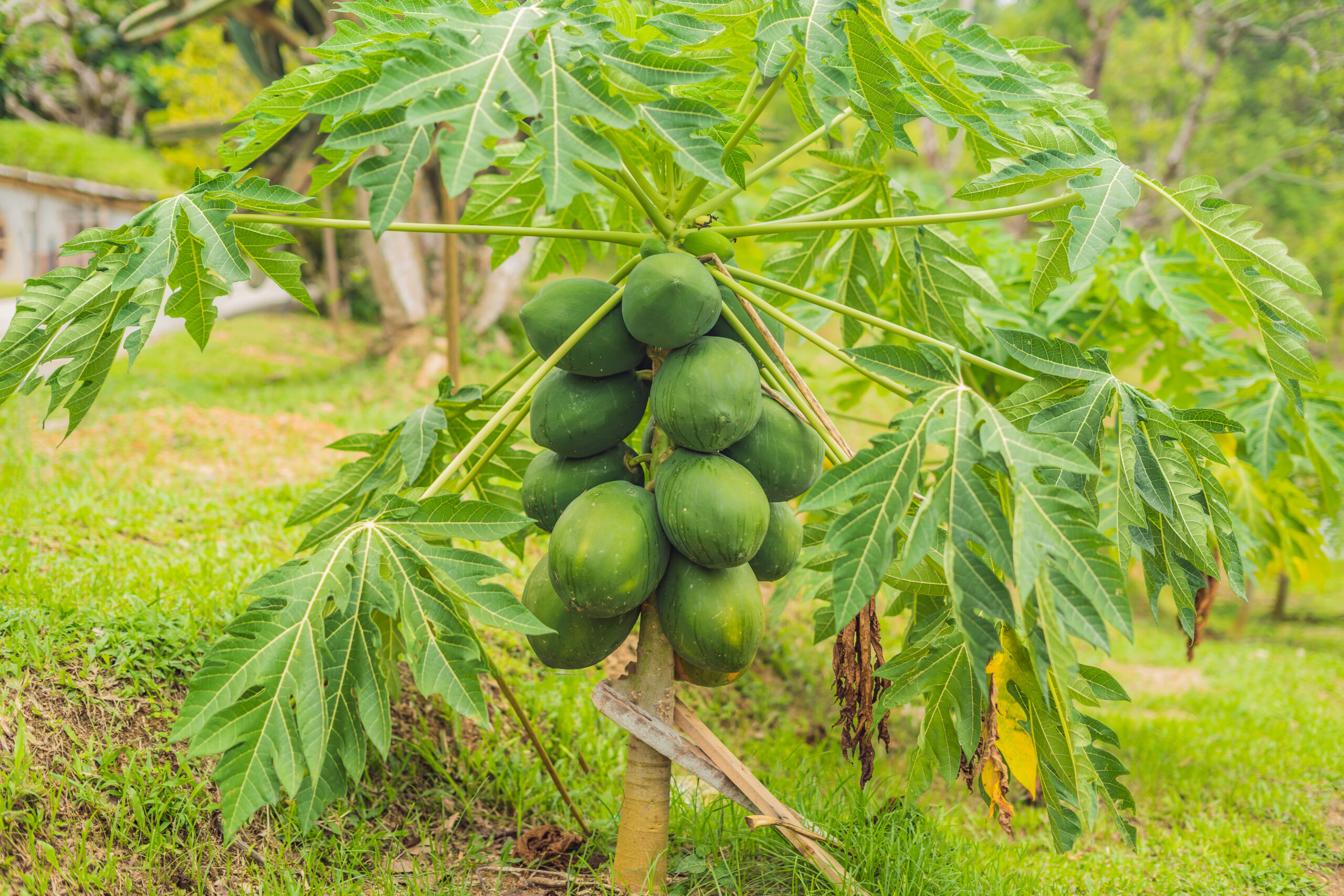Carica papaya is a tropical evergreen tree commonly grown for its sweet-flavored, buttery-textured fruit. Carica also can be grown as a houseplant; it bears interesting deeply lobed fanlike leaves.
There are two types of papaya: Hawaiian or “yellow papaya” and Mexican or “red papaya”.
Yellow, Hawaiian, papaya has yellow skin when ripe. Hawaiian papayas are pear-shaped and commonly weight about one pound. The flesh is bright orange or pinkish depending on the variety. Yellow papaya has a sweet, tropical-flavored when ripe. Yellow papaya trees seldom grow taller than 8 feet (2.4m).
Red, Mexican, papaya has a red skin when ripe. Mexican papayas are pear to oval-shaped; they are much larger than Hawaiian papayas, up to 15 inches (38cm) long, and they weigh as much as 10 pounds or more. The flesh of the Mexican papaya can be yellow, orange, or pink. The red papaya is less sweet than the Hawaiian papaya. Mexican papayas commonly grow 10 to 12 feet (3.6m) tall; in tropical regions, they can grow to 30 feet (9.1m) tall.
Get to know Carica
- Plant type: Evergreen tree
- Growing zones: Zones 8 to 10
- Optimal growing temperature: day, 70° to 75°F (21° to 24°C); night 65° to 70°F (18° to 21°C). and medium to high humidity.
- Height and width: In a container, Carica grows 5 feet tall (1.5m); outdoors Carica can grow 20 to 25 feet tall and 8 to 10 feet(2.4 to 3 m) wide; straight trunk topped by crown of leaves
- Foliage: Fanlike, deeply lobed leaves on 24 inch long stems
- Flowers: Inconspicuous cream-colored flowers
- Bloom time: Sping and summer
- Uses: Fruit tree, container plant, houseplant
- Common name: Papaya.
- Botanical name: Carica papaya
- Family name: Caricaceae
- Origin: Tropical America, southern Mexico and Central America

Where to plant Carica
- Plant Carica outdoors in full sun; in partial shade the fruit is not likely to sweeten.
- Indoors plant Carica in direct light.
- Plant Carica in a warm spot where there is plenty of sun and heat. Choose a south-facing spot against a wall that reflect heat when possible.
- Avoid planting Carica where there is a constant breeze and avoid planting in low spots that collect cold air. Wind can damage the fruit or topple the tree.
- Carica grows best in sandy, well-drained soil. Carica trees will not survive water-logged soil for more than a day. Where the soil can be damp, plant Carica on a mound to ensure good drainage.
- Indoors plant Carica in an all-purpose potting mix with good drainage.
- Papayas prefer a soil pH of 5.5 to 6.5.
When to plant Carica
- Set Carica outdoors in spring or autumn.
- To get the most fruit, don’t grow Carica as a permament tree. Have several plants in different stages of maturity growing on; old ones become less productive and can be destroyed.
Planting and spacing Carica
- Space Carica 8 to 10 feet(2.4 to 3 m) apart.
How to water and feed Carica
- Water: The soil should be kept moderately to evenly moist. Drying causes brown leaf tips. Mist frequently. Humidity is best at,40% to 50%.
- Feeding. Fertilize Carica every 2 weeks during growing season, with mild liquid fertilizer or fish emulsion diluted to ½ strength. Fertilized in spring and summer.
Carica care
- Carica rests during winter. Keep soil barely moist; withhold fertilizer.
- Carica will suffer in cool, drafty location.
Growing Carica as a houseplant
- Carica needs direct light, a warm temperature, and medium to high humidity.
- the soil should be kept moderately to evenly moist.
- Fertilize Carica in spring and summer.
- Carica benefits from being placed outdoors in summer, which can help produce lush foliage.
Carica pests and diseases
- Check Carica for spider mites, aphids, mealybugs, scale insects and thrips.

Carica propagation
- Propagate Carica by division or seeds.
- Carica can be propagated from seed saved from store-bought fruit. The seeds should be planted in an all-purpose soil mix to which sand has been added.
Carica varieties to grow
- Carica cataractarum, a dwarf clustering species, has black fruits.
- C. elegans, parlor palm, sometimes listed as collinia elegans or neanthe bella, has erect stems with dark green fronds and grows to 36 inches (91 cm). small pale yellow flowers appear occasionally, followed by black fruit.
- C. erumpens, bamboo plam, has clusters of slender stems and arching dark green fronds with broad, drooping leaflets. Grows to 10 feet (3 m) tall.
- C. glaucifolia is a decorative palm with narrow, blue-green fronds.
- C. seifrrizii has clusters of erect stems and narrow, grasslike leaflets. It bears fragrant male flowers, and tolerate more sun than other Chamaedorea species. C. papaya: has leaves up to 20 inches across.



